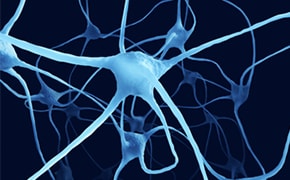세포 신호전달

세포 신호전달이란 접촉과 같은 기계적 신호 또는 호르몬, 성장인자, 신경전달물질과 같은 화학적 신호에 의해 움직이는 유기체 내의 세포 사이의 커뮤니케이션 기전을 의미합니다. 신호전달 경로에서 자극은 정확하고 적절한 반응을 나타내기 위하여 연쇄반응 과정을 통해 전달됩니다. 세포 신호전달 경로의 예로는 지질 신호전달, 인슐린 신호전달, 스트레스 신호전달, 성장 신호전달, TOR 신호전달, 관문 신호전달 등이 있습니다. 이 분야의 연구는 세포 역학 연구 및 모델링, 세포 신호전달 이질성 분석, 세포 신호전달과 다른 생물학적 프로세스 간의 교차, 신호전달 역학을 빈번히 취급합니다.
관련 자료
- Explore key targets of cancer research and cell signaling research with the DNA damage response (DDR) pathway and do a deep dive into ATM, ATR, and p53 mechanisms involved in DNA damage checkpoints.
- Lipopolysaccharide (LPS) is the major component of the outer membrane of Gram-negative bacteria. Lipopolysaccharide is localized in the outer layer of the membrane and is, in noncapsulated strains, exposed on the cell surface.
- Acetylcholine is synthesized from acetyl coenzyme A and choline by the enzyme choline acetyltransferase. In addition to its synthesis in the liver, choline employed in acetylcholine production is derived from dietary sources.
- 콜라겐 분해효소(Collagenase) 가이드입니다.동물의 조직을 하나로 결합하는 고유의 콜라겐을 분해하는 효소인 콜라겐 분해효소는 다양한 미생물과 여러 다른 동물 세포에 의해 만들어집니다.
- There are five identified glycosaminoglycan chains (see Figure 1): Hyaluronan is not sulfated, but the other glycosaminoglycan chains contain sulfate substituents at various positions of the chain.
- 모두 보기 (119)
관련 프로토콜
- This procedure is for informational purposes including assay Procedure, definition, and calculations for Protease
- A review and resources for ion channel flux assays and protocols, along with liposome formation and proteoliposome preparation protocols
- Protocol for Assay Procedure for Cholesterol Oxidase
- The Protease Fluorescent Detection Kit provides ready-to-use reagents for detecting the presence of protease activity. This simple assay to detect protease activity uses casein labeled with fluorescein isothiocyanate (FITC) as the substrate.
- 모두 보기 (12)
더 많은 관련 문서와 프로토콜을 찾아보세요.
계속하려면 로그인하세요.
계속 읽으시려면 로그인하거나 계정을 생성하세요.
계정이 없으십니까?